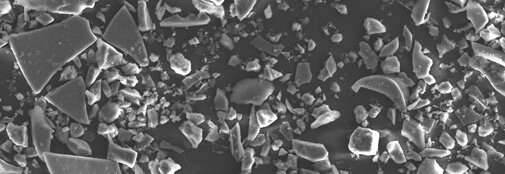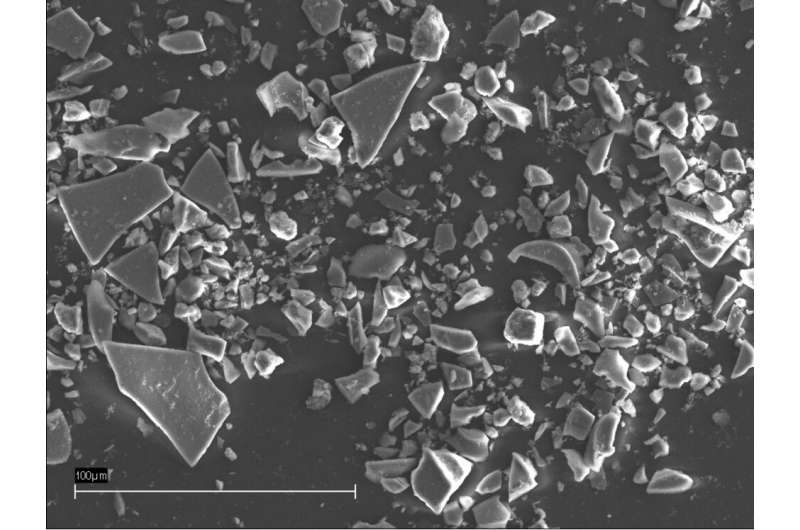Synchronization of ice cores using volcanic ash layers

Thin, brownish layers of a thickness of about a millimeter or two are sometimes observed in the whitish/transparent ice cores. These brown layers consist of material originating from volcanic eruptions.
During a volcanic eruption, gases, lava, rocks, and tiny ash particles are being ejected into the atmosphere. The smallest particles are carried by the wind and transported with the air masses, until the particles drop out and cover the land or ice surface with a thin blanket of volcanic material. Ash that landed on the ice sheet of Greenland thousands of years ago are buried under huge amounts of ice today and can only be retrieved by drilling long ice cores.
Many of the ash particles in the ice cores are too small to be visible to the naked eye. Most often the particles are only one tenth or one hundredth of a millimeter. Only when a huge amount of ash particles is present in a layer, the layer will be visible in the ice core as a thin brown band, but most of the volcanic layers in ice cores are invisible because of the small amount of ash shards. Searching for these ash layers in a three kilometer long ice core may seem like an impossible task. Nevertheless, this is what researchers at the Centre for Ice and Climate do.

The volcanic ash layers can be used as important reference horizons that can link different ice cores and other archives of past climate. The volcanic ash also contains a chemical fingerprint which makes it possible to trace which volcano the ash originates from, and sometimes also which eruption of a particular volcano was the source. It is this property that encourages the researchers to look for the tiny ash particles that are hidden in the long ice cores.
Identification and analysis of volcanic ash
It may seem like an impossible task to find the invisible ash layers in a three kilometer long ice core, consisting of about 20 tonnes of ice. Luckily, some help is at hand. Following a volcanic eruption, the precipitation is often slightly acidic due to the presence of sulphuric acid that comes from conversion of the volcanic sulphuric gases in the atmosphere. The relatively high acid concentrations lead to high electrical conductivity of the ice. It is fast and relatively easy to measure the electrical conductivity of the ice, and the acid peaks in the measured profile can be used as guides for where the tiny ash particles are hiding. Ice samples will usually be cut around where acid peaks are found, but unfortunately there is no guarantee that ash is present, so the samples have to be analyzed very carefully.

The ice samples are melted and centrifuged in order to pour off the water and keep the small amount of impurity particles from the ice. Most of the material is wind-blown dust or fine-grained sand, often coming all the way from deserts in Asia. If ash shards are present, these can be identified visually in a normal light microscope or in an electron scanning microscope.
An ash shard can often be identified by its glassy and shiny look, its particular shape and its transparency. The particles are normally either colorless or light pinkish or brownish, depending on the chemical composition.
After identification of an ash layer, the chemical analysis can start using an electron microprobe. This instrument works by shooting an electron beam at the ash particle investigated. The chemical composition of the shards can be inferred from the wavelengths of the X-rays that are emitted from the sample. Chemical results of good quality require that the samples are prepared well before analysis. This process is very laborious. All the shards to be analyzed need to have a flat and smooth surface and should be at the same level relative to the electron gun in the microprobe. One way to do this is to mount the shards in a resin (epoxy) on a glass slide and then polish the sample with fine-grained diamond dust. The surface of the sample is slowly being removed and polished by the hard diamond dust. Care is taken not to polish away all the precious shards. During the polishing, a microscope is used to check if the surface of the shard is flat and smooth.
When the chemical composition of the shards has been determined, the results are compared with results from analysis of similar shards in other ice or sediment cores or with the composition of ashes found in situ at the volcano responsible for the eruption.
More information: Brad S. Singer et al. Synchronizing volcanic, sedimentary, and ice core records of Earth's last magnetic polarity reversal, Science Advances (2019). DOI: 10.1126/sciadv.aaw4621
Journal information: Science Advances
Provided by University of Copenhagen

















